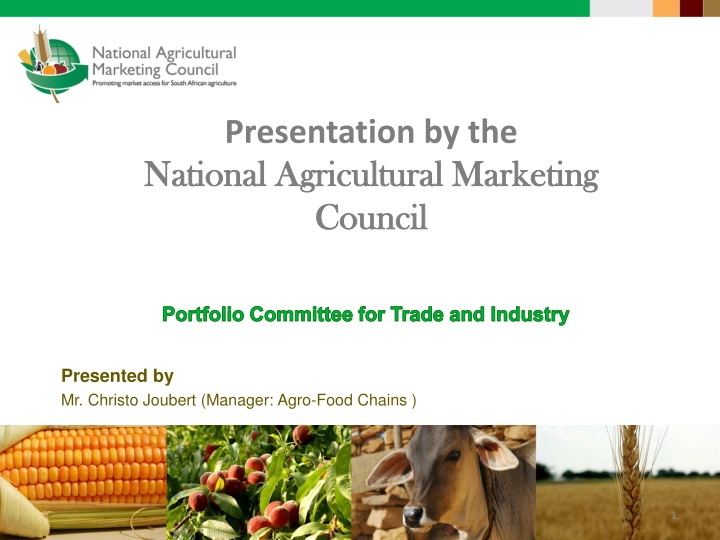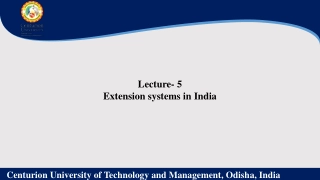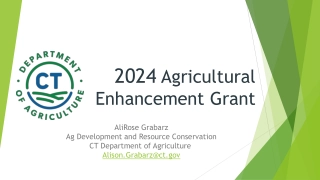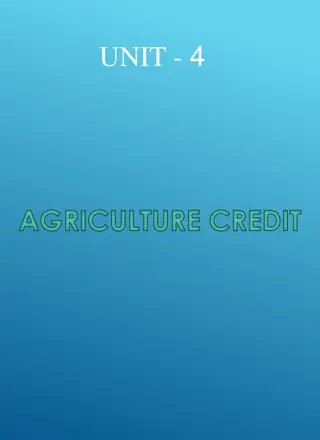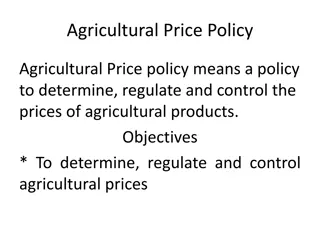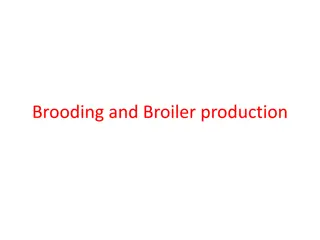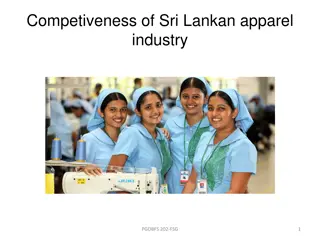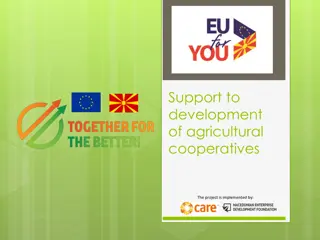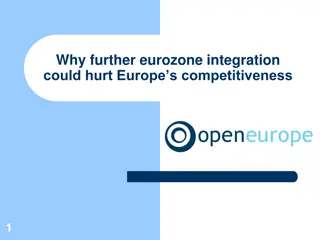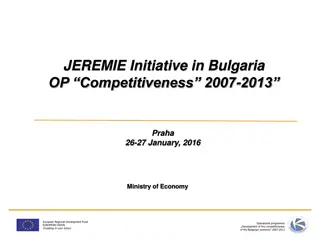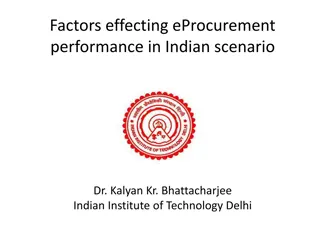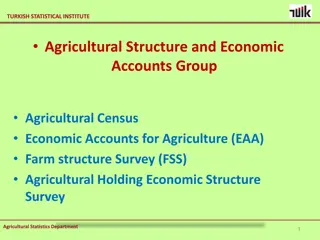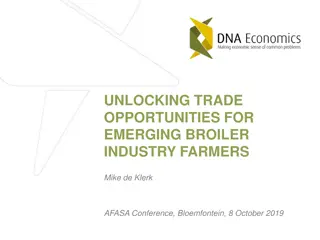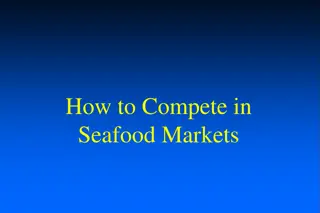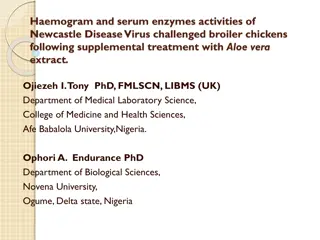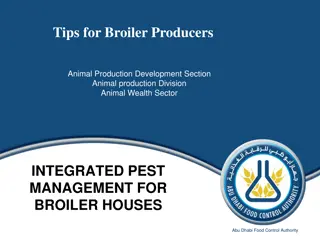Presentation by National Agricultural Marketing Council on Broiler Industry Competitiveness
This presentation by the National Agricultural Marketing Council delves into the competitiveness of the broiler industry in South Africa. It covers strategic objectives, legislative mandates, economic impacts, and policy analyses related to the broiler value chain. The study conducted by NAMC and BFAP evaluates the factors influencing competitiveness, economic effects of tariff relaxations, and industry impacts on other sectors. Insights on maximizing land use, enhancing productivity, and promoting inclusive growth are also discussed.
Download Presentation

Please find below an Image/Link to download the presentation.
The content on the website is provided AS IS for your information and personal use only. It may not be sold, licensed, or shared on other websites without obtaining consent from the author.If you encounter any issues during the download, it is possible that the publisher has removed the file from their server.
You are allowed to download the files provided on this website for personal or commercial use, subject to the condition that they are used lawfully. All files are the property of their respective owners.
The content on the website is provided AS IS for your information and personal use only. It may not be sold, licensed, or shared on other websites without obtaining consent from the author.
E N D
Presentation Transcript
Presentation by the National Agricultural Marketing National Agricultural Marketing Council Council Portfolio Committee for Trade and Industry Presented by Mr. Christo Joubert (Manager: Agro-Food Chains ) 1
Outline of Presentation The mandate and strategic objective of the NAMC Background of IDC Broiler study The integrated poultry value chain Competitive advantage: A Policy Analysis Approach Factors affecting the competitiveness of the broiler industry Economic and Socio-Economic Impact SAFRIM Model CGE/GTAP Analysis Looking at the affect of policy on the industry and do SA optimize resources effectively in the production of broilers What is the economic and socio-economic impact of the industry if tariffs is relaxed What is the effect of the industry on other sectors if tariffs is relaxed NDP, Phakisha, IPAP & APAP and the broiler industry 2
Legislative and Policy Mandate The NAMC was established in terms of sections 3 and 4 of the Marketing of Agricultural Products Act, No. 47 of 1996 (hereinafter referred to as the MAPA) as amended by Act No. 59 of 1997 and Act No. 52 of 2001. Mandate in general To advise Minister on broad strategic issues affecting the sector with special focus on marketing. NAMC has positioned itself to carry out this mandate as effectively as possible over the past few years NAMC is also coordinate implementation of key government programmes (SIP 11, AIMS, development projects, etc) National Development Plan Maximising use of communal land and enhancing productivity of land reform projects Opportunities to expand high value crops towards growth and job creation Revitalisation of irrigation Other policies Agriculture, forestry and fisheries strategic framework (AFF-SF) Agricultural Policy Action Plan (APAP) National Infrastructure Plan specifically coordination of SIP 11) Government Outcomes Outcome 4: Decent Employment through Inclusive Growth Outcome 7: Comprehensive Rural Development and Food Security. 3
Strategic Objectives As stipulated in the Marketing of Agricultural Products Act, No. 47 of 1996 the objectives of the NAMC are: Increasing market access for all participants Promotion of the efficiency in the marketing of agricultural products https://encrypted-tbn0.gstatic.com/images?q=tbn:ANd9GcTCKqOzfDx2jtMDV9_CPa9AptApzx1aZDbwmxlAV8n2F_Mv_ZENuQ Optimization of export earning from agricultural products Enhancement of the viability of the agricultural sector 4
Background of Broiler Study The NAMC & BFAP were commissioned by the IDC in 2014 to conduct a study on the broiler industry. The study was completed at the end of 2016. The title of the study is: Evaluating the competitiveness of the South African broiler value chain: An executive summary of the study is available at the following link: http://www.economic.gov.za/entities-external-links/entities-reports-a-research The study resulted in further analysis which part of it is presented in this presentation. 5
The Integrated Poultry Value Chain Source: NAMC: 2014. The following value chains form direct part of the integrated broiler value system: Maize production system/chain; Soybean production system/chain; Grain storage and handling Poultry feed manufacturing system/chain; Day-Old Chick production system/chain; other suppliers of equipment and machinery. Other indirect value systems Packaging and packing material Transport and roads Electricity and water Steel and construction Machinery and equipment Heavy Industrial Light industrial 6
Unpacking the chain 2014-15..continue Source: Briedenham (2013); Davids (2013), GrainSA (2015); SAPA (2016a), NDA, & own compilation. 9
Products, Quantities and Capacities in the chain Source: Briedenham (2013); Davids (2013), GrainSA (2015); SAPA (2016), NDA, & own compilation. 11
Competitive advantage: A Policy Analysis Approach 12
Competitive advantage: Difference between competitive and comparative advantage A clear difference exists between comparative and competitive advantage. Many economists believe when they compare two different regions or products, and the one product or region perform better than the other, it has a comparative advantage. Comparative advantage is unique to specific region. A region has a comparative advantage above another when the net margin of its business system is higher due to factors such as cheaper labour, better climatic and soil conditions, and distance to markets. A region has a competitive advantage if it can apply its natural resources, capital labour and entrepreneurial skills more optimally than another region can. 13
Results: Policy Analysis Matrix Revenue Cost Profit Tradable Inputs R 12 769 R 10 450 Non-Tradable Inputs R 2 435 R 2 015 Market/private Prices Economic Prices R 16 956 R 12 690 R 1 752 R 225 Effect of divergences and efficient policy R 4 266 R 2 319 R 420 R 1 527 Private Cost Ratio (PCR = C/(A-B) 0,58 Domestic Resource Cost Ratio (DRC =G/(E-F)) 0,90 Nominal Protection Coefficient (NPCO) on tradable outputs (A/E) 1,34 Nominal Protection Coefficient (NPCI) on tradable inputs (B/F) 1,22 Effective protection coefficient ((A-B)/(E-F)) 1,87 Profitability Coefficient (D/H) 7,79 Subsidy ratio to producers (L/E) 0,12 14
Discussion on the results Market/private profitability Profitability The market/private profit for the broiler system in South Africa is R1752 per tonne. Private Cost Ratio (PCR) The PCR for the industry is 0.58. Economic/social profitability Profitability The economic profit for the broiler system in South Africa is R225 per tonne. Domestic Resource Cost ratio (DRC) The DRC for the South African Broiler Industry is 0.9, which indicates that its comparative advantage is not so favourable. Therefore, government needs to focus on not burdening the industry with any direct or indirect taxes. 15
Discussion on the results Policy Transfer Nominal Protection Coefficient for outputs (NPCo) The NPCo is 1.34. This shows that policies increase output prices by 34 % because world prices do not set domestic prices. Nominal Protection Coefficient for inputs (NPCi) An NPC on inputs of 1.22 shows that policies are increasing input costs; the average market prices for these inputs are 22 % more than the world prices Effective Protection Coefficient (EPC) The industry measures an EPC of 1.87. The fact that the EPC is higher than one indicates that distortions in input markets should not be underestimated. The market price is influenced by 87 % through government policy. Profitability coefficient (PC=D/H) A profitability coefficient of 7.79 indicates that existing policy implications contribute as an incentive to produce broiler meat. Subsidy ratio to producers (SRP=L/E) Subsidy ratio to producers The SRP in this case is 0.12, which is an indication that support is received by the producers. 16
Effect of policy South Africa has a competitive and comparative advantage in the production of broilers. The poultry producing industry believes that South Africa is being used to receive dumped chicken meat. The current global situation reveals that South Africa needs support from government to secure a sustainable broiler industry. The profitability of broilers is dependent on the efficient allocation of inputs, and inputs are taxed relatively highly in comparison with the economic prices thereof. The current policy is exerting pressure on the comparative advantage of broiler production. 17
Proposed mechanism: The Effect of Policy & Comparative advantage The following imperatives need to be addressed: Efforts to decrease the costs of ingredients for feed need to continue. For example, the stimulation of investment in the local soybean processing industry. Information in the market can be enhanced, e.g. official supply and demand figures of poultry meat and substitutes. A case needs to be made whether dumping occurs in the market or not proper research needs to be done to inform policy decisions. The comparative advantage study reveals that the current tariff formulation protects the industry sufficiently, due to a positive profitability coefficient. The communication channel between industry and government bodies and decision makers needs to improve and to be put on a more permanent basis to convey industry information to policy makers. The industry needs to continue research, which needs to be funded by either industry or government. 18
Factors affecting the competitiveness of the broiler industry 19
Recommendations The findings serve as indicators to guide the industry to manage the various factors to improve the competitiveness of the industry. Several policy shifts can enhance the competitive of the industry. Industry role players indicate clearly what the most importing factors to increase competitiveness are: Input cost/production cost: The cost of feed: The volatility of the exchange rate: Cost of administered prices. Day-old Chicks: The quality of feed: Electricity supply: Price formation: Water supply: Infrastructure: Import and export environment: Labour law: Relationship and networking in the industry: Pricing strategies: Labour productivity: 24
Economic & Socio-Economic Impact 25
SAFRIM Model (2013 2033) GDP Scenario 2 531 787 2 530 871 2 530 522 2 535 453 2 532 214 Baseline 2 532 438 2 532 438 2 532 438 2 532 438 2 532 438 Difference -652 -1 567 -1 917 3 014 -224 Investment Impact Operational Cost Government Loss Disposable income Dynamic Impact Employment Baseline 16 226 233 16 226 233 16 226 233 16 226 233 16 226 233 Scenario 16 220 323 16 203 884 16 206 975 16 246 665 16 205 540 Difference -5 910 -22 349 -19 258 20 432 -20 693 Investment Impact Operational Cost Government Loss Disposable income Dynamic Impact 26
SAFRIM Model The net effect regarding GDP and employment is negative, which means that the economy will lose out regarding economic growth (GDP) and employment creation if the restrictions on the imports of broilers are relaxed. The GDP will decrease by R224 million and about 20 693 potential jobs could be lost. It is important to note that the GDP as well as the potential jobs, is an average value/number over the period 2013-2033. This means, for example, the potential jobs will decrease by 20 693 on average for a specific year over the programming period, if the tariff is relaxed; The negative GDP figure is relatively small, but the impact on employment is significant. In South Africa, where employment is crucial, this aspect should be considered in any decision to relax the tariff; The negative impacts on the economy are created by the lowered investment (GDP = R-652 million and Employment = -5 910 jobs), reduction in the local production of broilers (GDP = R-1 567 million and Employment = -22 349 jobs) and the decrease in government income (column 3, GDP = R-1 917 million and Employment = -19 258 jobs); and The positive impact on the economy is attributable to the price reduction of broilers in South Africa and its positive effect on the intermediate consumers of broilers and the private consumers (GDP = R3 014 million and Employment = 20 432 jobs). Currently there is no evidence that cheaper imports result in cheaper consumers prices. 27
SAFRIM Model: Summary The industry is very important for South Africa. Chicken meat is one of the most favoured and most affordable protein sources for South Africans. The industry is highly integrated into other industries and accounts for the biggest contributor to agriculture GDP. The industry, therefore, contributes highly towards food security and food sustainability. The economic impacts were calculated by making use of a general equilibrium modelling system which is of a dynamic and multi-sectoral nature, forecasting the economy in a bottom-up approach. Macroeconomic aggregates are built up from detailed levels at the industry or product level. The various impacts in this analysis are the loss in investment by the broiler industry, reduction in production (operational cost and profits) in the broiler industry, loss of government income from relaxing the import restrictions, and a positive effect on the buying power of the private consumer through a reduction in the price of broilers. The results of the scenario show clearly that the positive effects that the consumers will receive due to lower broiler prices will be outweighed by the negative effects which will impact on the broiler industry. It seems that there is a net loss of R 224 million in GDP and a reduction of 20 693 jobs, on average, per annum over the programming period. In conclusion, it can be said that the analysis shows clearly that the South African broiler industry should be safeguarded against unfair international competition which might have a significant negative effect on the South African broiler industry. It is important to note that the broiler industry in South Africa is also an industry that is a suitable start-up sector for upcoming small-scale farmers, and that the destruction of the industry could have a detrimental effect regarding poverty alleviation. 28
CGE/GTAP Model results The average protection rate for the broiler industry is 33.16 % in 2013. The South African business model for processing decreases the price of chicken meat due to the fact of brining. The previous calculation indicates an average of 22 % for IQF. This was not factored into the total equation. The CGE model indicates that relaxing protection will result in the quantity demand for endowments experiencing a decrease of 1.9 % in land, and 2.61 % in unskilled and skilled labour. Capital investment will also decrease by 2.61 %. It is also clear that a substitution effect of resources towards other industries will take place. The red meat/livestock sector will use 0.41 % more land, 0.05 % more skilled and unskilled labour, and 0.05 % more capital. 29
CGE/GTAP Model results.continue The demand at household level for imported poultry products increases by 64.6 %. It would be expected that it should be much higher. The explanation might be that the lower prices of goods imported are not transmitted to the consumers due to the dynamics of the supply chain. That is also why livestock or red meat prices do not decrease (0.08 %) so drastically with other grains (0.43 %) and processed food (1.26 %). Textiles decrease by 0.88 %, extraction products by 1 %, light manufacturing goods by 107 %, heavy manufacturing goods by 1.37 % and other services by 1.5 %. 30
CGE/GTAP Model results.continue The trade balance of poultry meat will be affected negatively by 70.44 %. Industries that will benefit from the relaxation of tariffs are the red meat industry (4.3 %), cereals & grains (0.27 %), other grains (6.9 %), processed food (5.57 %), textiles (2.59 %), light manufacturing (14 %), heavy manufacturing (35.89 %), and other services (7.49 %). The net effect is positive, at 4.16 %. Imports for poultry will increase by 79.56 %, meat/livestock will decrease by 0.4 %, cereal & grains by 0.09 %, other grains by 2.2 %, and processed food by 0,001 %. 31
Concluding remarks Small scale farming Anti dumping and the TDCA AGOA Export promotion Brining issue NDP, Phakisha, IPAP & APAP and the broiler industry 32
Thank you 33
